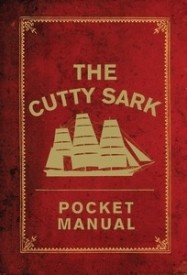 Pirates and Privateers Pirates and Privateers
The History of Maritime
Piracy
Cindy Vallar, Editor
& Reviewer
P.O. Box 425,
Keller, TX 76244-0425
    
Books for
Adults ~ Ships & Sailing

The Cutty Sark Pocket
Manual
by Arron Hewett and Louise Macfarlane
Osprey, 2018, ISBN 978-1-4728-3142-2, US $15.00 / CAN
$20.00 / UK £8.99
Also available in other formats
    
Cutty
Sark enters the world when tea is a vital
commodity in British trade; England imports
63,000,000 pounds that year. With her sharp bow,
streamlined hull, and 32,000 square feet of sails,
she is built for speed in the middle of the
Victorian Era. She has outlived both other extreme
clippers and many steamships that ply the seas when
she does. When tea ceases to be profitable, she
transports other cargo until she earns her place in
history as the fastest ship in the Australian wool
trade. Later, navy sailors and merchant seamen train
aboard her, and today she teaches visitors about
wooden ships and their role in maritime history
despite the destructive fire that sweeps through her
in 2007. Although this book discusses her entire
history, the authors focus on her first twenty-six
years when steamships are gaining importance in
maritime trade. And who better to share her story
than her general manager and her curator?
They set the stage with their introduction to the
tea trade and the emergence of clipper ships, as
well as world events – the Opium Wars and Suez
Canal, for example – that impact maritime trade and
shipping. Their goal in writing this pocket manual
is to explain why Cutty Sark survives when
her contemporaries are long since relegated to
history books or forgotten entirely.
Subsequent chapters discuss her construction, her
voyages, how ships work, her captains and crew, life
on board, her cargoes, and her history once she
ceases to be a British merchant ship. Launched on 22
November 1869, Cutty Sark has a wooden hull
affixed to an iron frame. She is built by Scott
& Linton, who goes bankrupt as a result of her
construction, and owned by John Willis, Jr., who is
wily, ruthless, and known as “White Hat Willis”
because of his white top hat. She sets sail on her
maiden voyage to China in February the following
year, and when she returns to London, she holds the
fourth fastest record for the year. But her travels
are not without problems. Like all ships, she
encounters Mother Nature and endures her wrath. On Cutty
Sark’s maiden journey one of the crew dies of
dysentery. On the “Hell-Ship Voyage” (1880) a seaman
is murdered, another becomes a fugitive, and the
master commits suicide. Richard Woodget serves as
her seventh and last master as a British vessel.
During his decade-long tenure, he provides a
photographic record of life aboard the clipper. He
resurrects her reputation and even overhauls a
steamer to reach Sydney before Britannia does
in 1889.
In addition to an index, the authors include
black-&-white illustrations (including some of
Woodget’s photographs), tables, maps, diagrams, and
entries from logbooks to enrich the reading
experience. Despite its size, this small, thin book
brims with fascinating history about this famous
ship. Most readers know of Cutty Sark, but
few know what she and her crews endure. The authors
correct this oversight and enlighten us so even
those who are unable to actually visit her come to
understand why she has left such an indelible mark
on our memories.
Review Copyright ©2019 Cindy Vallar

Click to contact me
Background image compliments
of Anke's Graphics |

